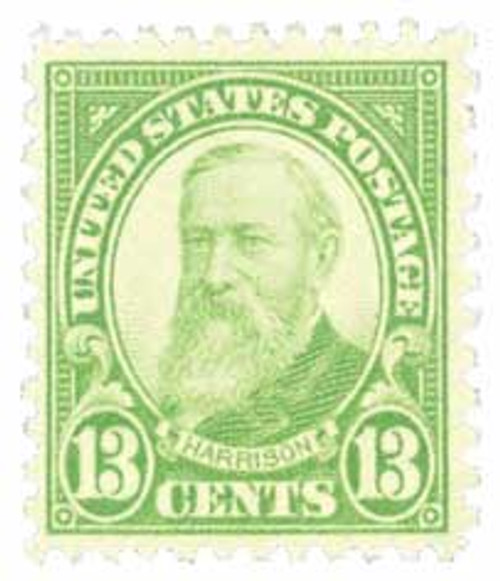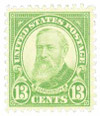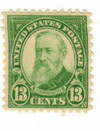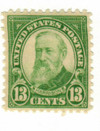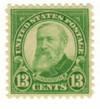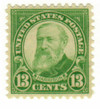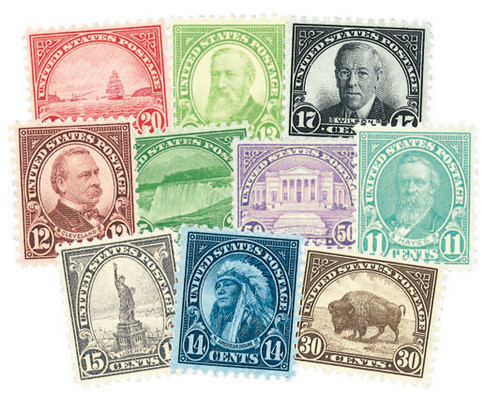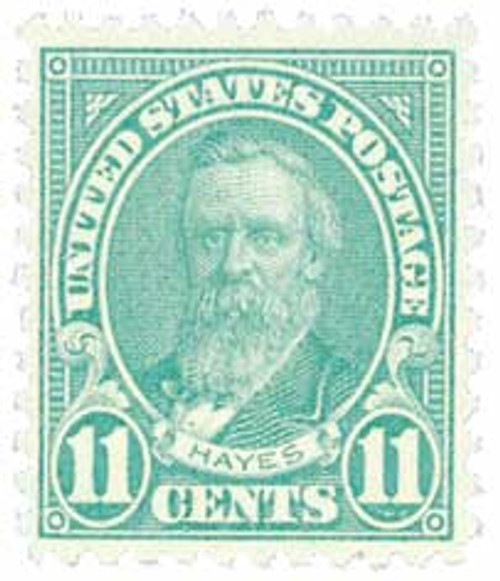
# 694 - 1931 13c Harrison, yellow green
1931 13¢ Benjamin Harrison
Issue Date: September 4, 1931
First City: Washington, DC
Birth Of Benjamin Harrison
The second of ten children, Harrison did not grow up in a wealthy household, despite his family’s distinguished roots. His father chose to spend the farm’s income on his children’s education. Young Harrison spent much of his childhood outdoors hunting and fishing. Benjamin was seven when his grandfather, William Henry Harrison, was elected president of the United States. They’re the only grandfather and grandson to serve as US presidents.
When the Civil War began, Harrison wanted to join the Union Army but worried he would not be able to financially support his family. In 1862, Harrison visited Governor Oliver Morton, who was worried about the state’s lack of soldiers. The governor asked Harrison to recruit a regiment, but not serve. Once Harrison had assembled his soldiers, Morton offered him command of the unit, but he refused because of his lack of military experience. Harrison was then commissioned a second lieutenant.
After the war, Harrison represented the government in a civil claim that earned him public attention. He also received high praise from his party for his numerous speeches in support of Republican candidates..
Harrison was inaugurated on March 4, 1889, the 100th anniversary of George Washington’s first inauguration as President, earning him the nickname “Centennial President.” One of the first issues Harrison dealt with was civil service reform. Harrison also took joy in seeing the Dependent and Disability Pension Act go into effect, a cause he had worked for while in Congress. The act provided pensions to disabled Civil War veterans and reduced the Federal budget surplus.
President Harrison made several attempts at civil rights reforms, though he had little success. Among these was a bill that would “secure all our people a free exercise of the right of suffrage and every other civil right under the Constitution and laws.” Although the bill was defeated in the Senate, Harrison continued to speak publicly about the rights of African-Americans.
During Harrison’s time in office, technological advances were made in countless industries across the country. Harrison was the first president to have his voice recorded and preserved. He also had electricity installed in the White House. Interestingly, he and his wife feared electrocution so they did not want to touch the light switches. As a result, they often slept with the lights on.
In 1891, Harrison narrowly averted war after the minister to Chile granted asylum to Chileans seeking refuge from thier nation’s civil war. Tensions increased when two American sailors were killed and 36 were arrested when they attempted to take a brief shore leave there. Harrison personally drafted a letter demanding their release and an apology, which greatly infuriated the Chilean minister of foreign affairs. President Harrison nearly ended diplomatic relations, but the matter was resolved when Secretary of State James Blaine returned to Washington and made pleas for peace, ending the standoff.
With the silver and tariff issues still in question and the Panic of 1893 looming, Harrison narrowly won his renomination bid at the 1892 Republican Convention. In a rematch of the 1888 election, he faced off once again against Grover Cleveland. However, this time, many who had previously supported high tariffs now favored reform, granting Cleveland growing support. To make matters worse for Harrison, his wife died just two weeks before the election. In the end, Harrison lost the election to Cleveland by 132 electoral votes and over 380,000 popular votes..
In February 1901, Harrison developed a bad cold he never recovered from. President Harrison died of pneumonia on March 13, 1901.
1931 13¢ Benjamin Harrison
Issue Date: September 4, 1931
First City: Washington, DC
Birth Of Benjamin Harrison
The second of ten children, Harrison did not grow up in a wealthy household, despite his family’s distinguished roots. His father chose to spend the farm’s income on his children’s education. Young Harrison spent much of his childhood outdoors hunting and fishing. Benjamin was seven when his grandfather, William Henry Harrison, was elected president of the United States. They’re the only grandfather and grandson to serve as US presidents.
When the Civil War began, Harrison wanted to join the Union Army but worried he would not be able to financially support his family. In 1862, Harrison visited Governor Oliver Morton, who was worried about the state’s lack of soldiers. The governor asked Harrison to recruit a regiment, but not serve. Once Harrison had assembled his soldiers, Morton offered him command of the unit, but he refused because of his lack of military experience. Harrison was then commissioned a second lieutenant.
After the war, Harrison represented the government in a civil claim that earned him public attention. He also received high praise from his party for his numerous speeches in support of Republican candidates..
Harrison was inaugurated on March 4, 1889, the 100th anniversary of George Washington’s first inauguration as President, earning him the nickname “Centennial President.” One of the first issues Harrison dealt with was civil service reform. Harrison also took joy in seeing the Dependent and Disability Pension Act go into effect, a cause he had worked for while in Congress. The act provided pensions to disabled Civil War veterans and reduced the Federal budget surplus.
President Harrison made several attempts at civil rights reforms, though he had little success. Among these was a bill that would “secure all our people a free exercise of the right of suffrage and every other civil right under the Constitution and laws.” Although the bill was defeated in the Senate, Harrison continued to speak publicly about the rights of African-Americans.
During Harrison’s time in office, technological advances were made in countless industries across the country. Harrison was the first president to have his voice recorded and preserved. He also had electricity installed in the White House. Interestingly, he and his wife feared electrocution so they did not want to touch the light switches. As a result, they often slept with the lights on.
In 1891, Harrison narrowly averted war after the minister to Chile granted asylum to Chileans seeking refuge from thier nation’s civil war. Tensions increased when two American sailors were killed and 36 were arrested when they attempted to take a brief shore leave there. Harrison personally drafted a letter demanding their release and an apology, which greatly infuriated the Chilean minister of foreign affairs. President Harrison nearly ended diplomatic relations, but the matter was resolved when Secretary of State James Blaine returned to Washington and made pleas for peace, ending the standoff.
With the silver and tariff issues still in question and the Panic of 1893 looming, Harrison narrowly won his renomination bid at the 1892 Republican Convention. In a rematch of the 1888 election, he faced off once again against Grover Cleveland. However, this time, many who had previously supported high tariffs now favored reform, granting Cleveland growing support. To make matters worse for Harrison, his wife died just two weeks before the election. In the end, Harrison lost the election to Cleveland by 132 electoral votes and over 380,000 popular votes..
In February 1901, Harrison developed a bad cold he never recovered from. President Harrison died of pneumonia on March 13, 1901.

